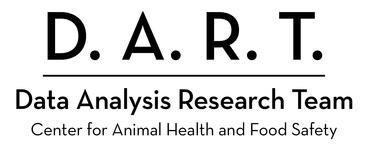Building & improving systems for the prevention and mitigation of disease impact through the use of quantitative epidemiology methods
In partnership with researchers at the University of Minnesota and other institutions, the data analysis and research team (DART) uses analytical tools for research and outreach.
The ultimate goals of DART are to generate new theoretical and applied knowledge, to transfer knowledge to decision-makers working in the public and private spheres, and to educate the new generation of decision-makers in the use and application of these technologies.
DART focuses on building bridges between academia and the industry, providing a service to practitioners and farmers, and contributing to animal health and production.
The DART group utilizes five main analytical tools:
- Risk assessment
- Mapping and spatial investigation
- Modeling
- Identifying factors promoting and preventing disease transmission
- Designing and analyzing observational and experimental studies
CAHFS and the University of Minnesota vision on data analysis and its relationship to management and policy is described in the following article written by Dr. Andres Perez.
